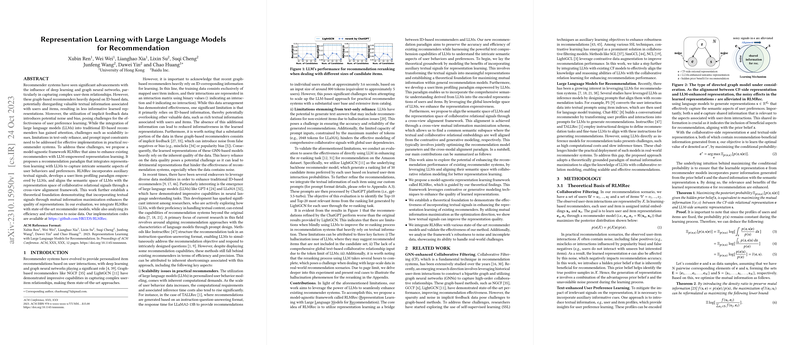Representation Learning with LLMs for Recommendation
This paper, presented at the ACM Web Conference 2024, introduces an advanced model-agnostic framework, RLMRec, designed to enhance traditional recommender systems using LLMs. The research addresses the limitations of graph-based recommenders that primarily rely on ID-based data, which potentially overlooks rich textual information associated with users and items. The authors propose integrating LLMs into recommendation systems to capture semantic aspects of user behaviors, thereby overcoming challenges related to scalability, text-only reliance, and implicit feedback noise.
Core Contributions
RLMRec serves as a bridge to effectively incorporate LLM-powered representation learning into existing recommendation frameworks. The approach is theoretically grounded in mutual information maximization, ensuring that the integration of textual signals improves representation quality. The framework employs:
- Auxiliary Textual Signals: It leverages LLMs for user and item profiling, utilizing enhanced semantic representations to enrich user preference learning.
- Cross-View Alignment: The framework aligns the semantic space of LLMs with collaborative signals, employing a cross-view mutual information maximization scheme that bridges textual and relational embeddings.
Numerical Results and Findings
The paper evaluates RLMRec against state-of-the-art recommender models, including LightGCN and SimGCL, demonstrating substantial improvements across multiple datasets like Amazon-book, Yelp, and Steam. For instance, the integration of RLMRec-Con with LightGCN improved Recall@10 by 5.9% and NDCG@20 by 5.5% on the Amazon-book dataset. These results are statistically significant, underscoring the framework's effectiveness in handling real-world recommendation challenges while maintaining robust performance.
Theoretical and Practical Implications
The incorporation of LLMs through mutual information maximization presents a significant step forward in enhancing the quality of learned representations by mitigating noise effects from implicit feedback. Theoretically, this work expands the understanding of aligning semantic knowledge with user-item interactions, offering a robust approach to integrating LLM capabilities in recommendation systems.
Practically, RLMRec provides a scalable and efficient method to leverage textual information, critical for improving recommendations in environments with large-scale user behavior data and diverse item catalogs. The framework's capacity to infer richer semantic representations could potentially transform how recommendation systems are designed, focusing on quality over mere interaction frequency.
Future Developments
Moving forward, the research opens several intriguing avenues for further exploration:
- Optimization of Text Embedding Models: Investigating the impact of different textual embedding models can aid in maximizing semantic alignment benefits.
- Enhancements in Semantic Profiling: Developing more sophisticated profiling techniques could refine user/item representations, further improving recommendation accuracy.
- Scaling LLM Integration: Addressing the computational challenges associated with LLMs, especially in large-scale applications, to ensure the practicability of RLMRec in real-world scenarios.
By addressing the limitations of traditional ID-based recommenders and incorporating the semantic depth offered by LLMs, this research marks a significant advancement in the field of recommendation systems, paving the way for more informed and contextually aware user interactions.
